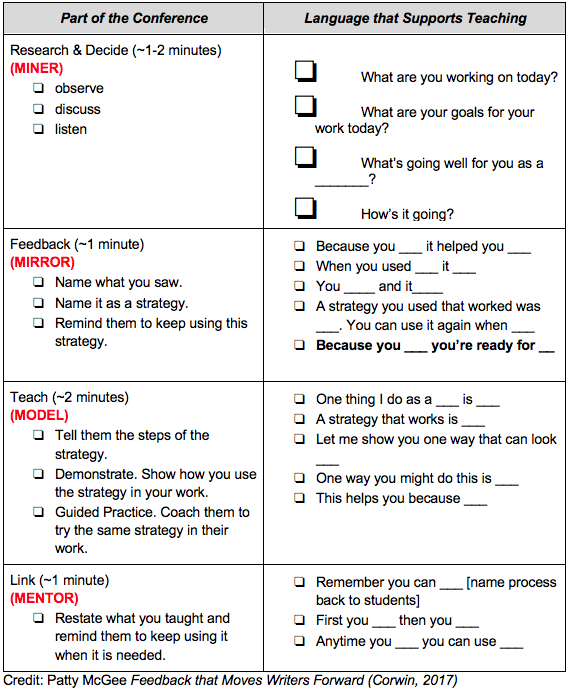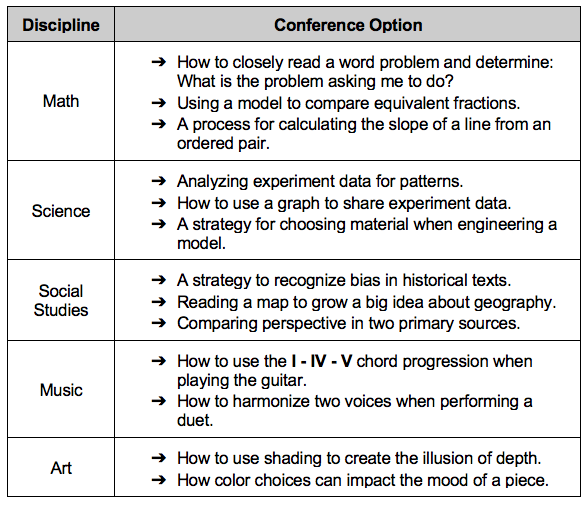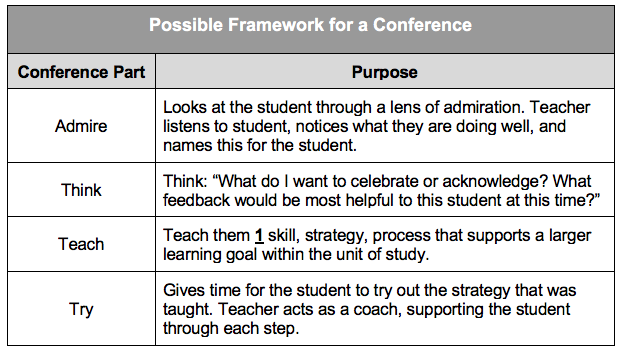Conferring: A Powerful Tool Across Disciplines

Conversation connects us. But think about how different our conversations can be.
There are times when my husband and I have a quick check-in talk. We discuss what time our boys need to be picked up at karate or what we need from the grocery store for dinner. Other times we engage in deep discussions envisioning our next home or how we will support one another as we pursue our professional goals.
While both of these conversations serve their purpose, they don’t achieve the same level of depth of meaning. This is also true of our conversations with students.
Teachers check-in with students frequently. These conversations are necessary and serve their purpose, but if those quick drive-by interactions are the only way we are talking to students about their learning, we’re missing the beautiful opportunity to connect and engage in meaningful discussion.
That is where the conference comes in. The teaching conference is that deep conversation. And while many of us are more familiar with the conference in a balanced literacy model, it is a powerful teaching tool that can be used across disciplines – teachers in math, science, social studies and other subjects will want to try this, too.
Check-In vs. Conference
So, what’s the difference?
A check-in is quick scan of the room. A teacher might use this time to gather some whole-class research about what students are doing and what students might not yet be doing. A teacher could stop alongside a student and offer a brief reminder (“Remember we simplify fractions into lowest terms.”) or could prompt to focus the student’s attention on an aspect of their work (“Can you reread your evidence and think about how it supports your claim?”)
These quick check-ins can be useful in helping teachers notice patterns, plan instructional next-steps, and intentionally group students. Then what’s the issue? If you’re only “checking in” with students you are missing the opportunity for individualized instruction and meaningful targeted feedback. That’s where the conference comes in.
Carl Anderson says, “A conference isn’t the icing on the cake; it is the cake.” It is through conferring that we build our classroom community and honor each and every learner in front of us. It’s how we remain present and connected to the students we teach. Conferring is too important to be an add-on or a maybe. It is a structure that deserves its rightful place in all classroom tapestry.
Conferring Across Disciplines
Since individualized instruction and meaningful feedback are good practice, no matter what discipline we teach, the conference helps us meet these goals. But you might be wondering, “What do I teach in a math or social studies conference?”
Many of our disciplines are a balance of content knowledge and skills. In recognizing what students need to know and then what students need to be able to do with what they know, you have just helped yourself focus on possible teaching points. Zooming in on what students need to DO (the skills that help learners make sense of the content) offers possibilities for a conference.
The chart below might help you envision conferring choices across disciplines:
A Framework for Conversation
When we gain confidence in what we could teach in a conference, having a structure as to how the conference might go is helpful. I have found that when I work for a conference to be supportive and positive, and not a question and answer session, it helps shift my lens to one of admiration rather than one of critique.
Choosing how I show up in a conference creates a space to honor what the learner is doing and determine possible next steps. Once I have clarity in my purpose, a framework is helpful to keep the conversation focused, yet productive.
Carl Anderson’s A Teacher’s Guide to Writing Conferences (2018) recommends Discover, Assess, Decide, Teach as the conference framework while Gravity Goldberg offers the 4 M’s (Miner, Mirror, Model, Mentor) in her book Mindsets and Moves (2016). The terminology might have slight variations, but what remains constant is we as teachers approach the conference with the intention of looking at what a student is doing and teaching the student an explicit strategy that will help them grow as a reader, writer, mathematician, historian, scientist, artist, etc.
Using language that is supportive of the learner is essential to honing your conferring practices. Having language prompts (see chart below) at your ready is one helpful strategy if you are entering into this work. Once you start conferring consistently, you will find language that feels most authentic to you, your students, and your discipline.

Download here
Go Ahead, Try It!
So as you continue to engage in conversations with students, ask yourself: “Am I checking in? Or am I conferring?” Notice how you enter into these conversations and allow yourself to try a conference. It might be risky, but it will be worth it.
References:
Anderson, C. (2018). A teacher’s guide to writing conferences. Portsmouth, NH: Heinemann.
Anderson, C. (2000). How’s it going?: a practical guide to conferring with student writers. Portsmouth, NH: Heinemann.
Goldberg, G. (2016). Mindsets & moves: strategies that help readers take charge. Thousand Oaks, CA: Corwin.
McGee, P. (2017). Feedback that moves writers forward. Thousand Oaks, CA: Corwin. (See her MiddleWeb post with links to online resources.)
Serravallo, J. (2019). A teacher’s guide to reading conferences: grades K-8. Portsmouth, NH: Heinemann.
Katie McGrath is a middle school instructional coach and facilitator. Prior to coaching, she taught middle school language arts for 12 years. Katie has written literacy curriculum for the middle school, and she coaches in classrooms regularly.
Katie has studied with Gravity Goldberg and her team of literacy consultants for many years and is a proud member of the Gravity Goldberg LLC Coaching Co-op. She is a current member of NCTE and the Lit Together Think Tank as well as a faculty leader at the Paramus Summer Literacy Institute. Follow Katie on Twitter @MrsKTMcGrath.





































